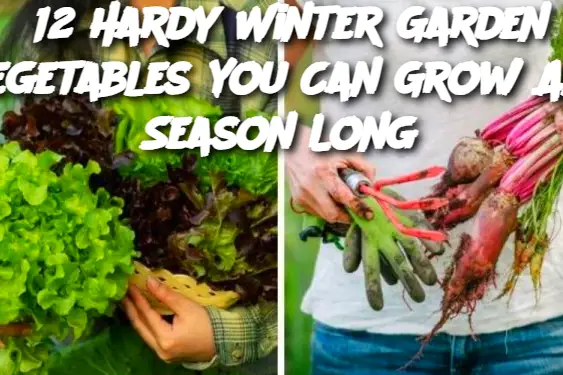Leeks
Leeks are another hardy vegetable that flourishes in cold weather. They can be planted in late summer or early fall and harvested through the winter. They are perfect for soups, stews, and other hearty winter dishes.
Winter Squash
While winter squash requires a longer growing season, it’s still a great option for a winter garden. Varieties like butternut, acorn, and spaghetti squash mature in the fall and can be stored for months, providing fresh produce throughout the winter.
Cabbage
Cabbage is an incredibly hardy vegetable that can survive frost. It grows best in cool weather, and varieties like savoy cabbage can withstand winter temperatures. It’s great for making soups, stews, and even fermented foods like sauerkraut.
Chard
Swiss chard is an excellent choice for winter gardens, as it can tolerate light frost and continues to grow in cold weather. The vibrant leaves are rich in nutrients and can be used in many dishes, from stir-fries to salads.
Radishes
Radishes grow quickly, and certain varieties are perfect for winter gardening. Plant them in late summer or early fall, and you can harvest them into the winter. They can handle frost and are great for salads or as a garnish.
Mustard Greens
Mustard greens are an excellent option for winter gardening. They tolerate frost and cold weather very well and can be used in a variety of dishes. Their peppery flavor makes them a great addition to soups and stews.
Instructions for Planting and Growing:
Choose the Right Varieties:
Select cold-hardy varieties suited to your region’s winter climate. Some varieties of kale, cabbage, and spinach are specifically bred to handle frost and low temperatures.
Prepare Your Soil:
Winter vegetables thrive in well-drained, fertile soil. Make sure to amend your soil with compost or organic matter to ensure healthy growth. Raised beds or containers can also help improve drainage during the winter months.
Use Cold Frames or Row Covers:
To protect plants from harsh winds and extreme cold, use cold frames or row covers. These create a microclimate that can extend the growing season and protect plants from frost. You can also use hoops or greenhouses to provide extra protection.
Plant in Fall:
Many winter vegetables need to be planted in the fall to ensure a winter harvest. Garlic, for example, should be planted in late autumn to grow over the winter. Root vegetables like carrots and beets can be planted in late summer or early fall for a winter harvest.
Harvest at the Right Time:
Be sure to monitor your crops for maturity. Some vegetables, like carrots, can be harvested later in the winter, while others, like kale and spinach, are best harvested as needed. Winter squash can be harvested in late fall and stored for winter use.
Tips for Serving and Storing Winter Vegetables:
Serving Tip:
Many winter vegetables, such as kale, leeks, and cabbage, work wonderfully in soups, stews, and casseroles. Roasted vegetables like carrots and beets also shine during the colder months. For leafy greens, a quick sauté with garlic and olive oil makes a delicious side dish.
Storing Winter Vegetables:
Root vegetables like carrots, beets, and radishes can be stored in a cool, dark place such as a basement or root cellar. Keep them in bins with sand to maintain moisture and prevent shriveling. Winter squash and garlic can be stored in a cool, dry area for several months. Leafy greens like kale and spinach can be stored in the refrigerator for up to a week.
Variants for Winter Gardening:
Succession Planting:
To maximize your winter harvest, try succession planting. This involves planting crops in stages, allowing you to harvest vegetables throughout the winter. For example, you can plant a second round of spinach or radishes in early fall to extend the harvest.
Growing Indoors:
If you don’t have a lot of outdoor space, you can grow certain winter vegetables indoors. Leafy greens like spinach, kale, and mustard greens can thrive in containers indoors with the right light and temperature conditions.
Companion Planting:
Companion planting can also help boost your winter garden’s productivity. For example, planting garlic near roses can help protect them from pests, while planting cabbage with peas can improve soil nitrogen levels.
FAQ:
Can I grow winter vegetables indoors?
Yes, many winter vegetables like leafy greens can be grown indoors if you have enough light. Use containers with good drainage and place them near a sunny window or under grow lights.
How do I protect my winter vegetables from frost?
To protect vegetables from frost, use row covers, cold frames, or mulch. These methods provide insulation and protect plants from freezing temperatures.
Can I plant these vegetables in containers?
Absolutely! Many winter vegetables, such as spinach, kale, and leeks, do well in containers. Just ensure the containers have good drainage and are large enough to support the roots.
What’s the best time to plant winter vegetables?
Most winter vegetables should be planted in late summer or early fall. Some, like garlic, should be planted in the fall and harvested the following summer, while others can be planted later in the season and harvested in winter.
How do I know when to harvest my winter vegetables?
Winter vegetables like carrots, beets, and leeks are ready for harvest when they reach full size, usually after a few months of growth. Leafy greens can be harvested as needed, starting with the outer leaves. Always check the maturity of each vegetable before harvesting.
Conclusion:
Growing winter vegetables is a great way to extend your gardening season and ensure you have fresh produce even during the colder months. With the right planning, care, and protection, you can grow a variety of vegetables in winter, from hearty greens like kale to root vegetables like carrots and beets. Whether you’re a seasoned gardener or a beginner, these 12 winter vegetables will help you get the most out of your garden, no matter the season. Happy gardening!
ADVERTISEMENT

